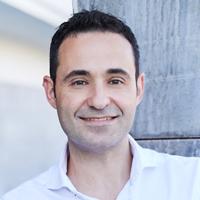Rare Disease Day 2024 – The importance of shining a light on rare diseases

I have spent the last 15 years working in rare diseases, working with some of the most dedicated ambassadors for rare disease, from researchers to patient advocates to patients and families.
What motivates me to dedicate my career to rare diseases and continually drive for change is best encapsulated in three words - purpose, passion, and pain.
The ‘purpose’ that keeps me – and Chiesi – motivated, continues to be the belief that every patient deserves to access optimal care and lead a fulfilling life. Witnessing first-hand the challenges involved in addressing unmet needs in small patient populations is humbling and also motivating as we show incrementally how we can overcome challenges.
The ‘passion’ is sharing the grit and determination of the patient communities affected by rare diseases, and seeing their hope reinforced when innovation succeeds and, finally, brings potential solutions.
Such purpose and passion, often comes with ‘pain’ in the form of feeling the immense impact on those living with a rare disease and their families. System-wide challenges including limited patient management options, a complex research and development (R&D) environment, and challenging access hurdles compound this pain further.
Commonalities in rare disease: Navigating high burden, low awareness, and health economics
Rare diseases, as the term suggests, typically affect small patient populations1 and are complex in nature, with a high burden of disease. Some of the common challenges faced by people affected by rare diseases include accessing optimal care and specialist services and, more broadly, limited knowledge, expertise, and awareness levels about their condition.2
From a research perspective, rare disease trials often require innovative design, which makes conducting R&D more nuanced.3,4 When trials are successfully initiated and completed, economic viability is often challenging, due to the high cost of developing and manufacturing orphan medicines.5 Orphan drugs, compared to treatments for standard medicines, have significantly lower success rates in reaching the market – with only a 6.2% success rate.6
These unique factors are well summarised by the patient advocacy organisation EURORDIS (European Rare Disease): “Due to the low prevalence of each disease, medical expertise is rare, knowledge is scarce, care offerings inadequate, and research limited. Despite their significant numbers collectively, rare disease patients are the orphans of health systems, often denied timely diagnosis, treatment, and the benefits of research.”7
For me, these challenges make it all the more important to invest in, and support, rare disease communities, as they are evidently at a distinct disadvantage.
It is also for these reasons that Rare Disease Day, which takes place every February and is coordinated by EURORDIS, is so important. The #LightUpForRare8 theme highlights the issues faced by patients and their families living with the day-to-day realities of a rare disease and calls upon healthcare systems to support timely diagnosis and access to better services. Rare Disease Day also provides an opportunity to focus policymakers on working collaboratively with industry, patient groups, and clinicians to accelerate innovation for scientific and societal benefit.
Realities of living with a rare disease in the UK today
Over 7,000 conditions are classed as a rare disease9 and in the UK approximately 1 in 17 people will be affected by a rare disease, representing around 3.5 million people.10,11 Despite these prevalence rates, many people struggle to receive a timely diagnosis, with a third of UK patients waiting for more than five years.2
Even once diagnosed, the personal toll on those living with a rare disease is profound, affecting both physical and mental health and severely impacting quality of life.12 This is even more poignant when you consider that 75% of rare disease patients are children13 and that a large majority (72%) are genetic,7 which may come with additional feelings of lack of control, bad luck, and even guilt in some cases. This makes rare diseases highly personal and emotive and places a significant strain on family life.
Day-to-day practicalities, such as travelling to and from specialist centres regularly, significant caregiver requirements that often limit the ability of parents to work, and the impact on family finances further exacerbate the impact of rare diseases.14
This unique set of circumstances makes advocacy organisations for rare diseases crucial and a powerful voice for patients within health policy making. Many have a very personal connection to the disease – for instance, a parent turned activist advocating for their child and others affected, in areas where support did simply not exist.
Communicating the purpose, passion, and pain
As I look to the efforts of the community on Rare Disease Day 2024 and beyond, I feel that it is essential we continue working together to make a difference for patients in dire need.
Remaining highly attuned and alert to the voice and needs of patients is key. Here at Chiesi, we do this by working closely and collaboratively with the rare disease communities to ensure that the gaps and challenges faced by patients are at the forefront of our efforts – from clinical research to patient support programmes and, crucially, to communication.
References
- Chung CYC, Hong Kong Genome Project, Chu ATW, et al. Rare disease emerging as a global public health prority. Front. Public Health, 18 Oct 2022, 10
- Genetic Alliance UK and Rare Disease UK. Available at: Rare-Disease-UK-Good-Diagnosis-Report-2022-Final.pdf (geneticalliance.org.uk) [Accessed February 2024]
- Kamusheva M, Milushewa P (2021) Rare disease patients’ needs: an up-to-date analysis and future directions. Pharmacia 68(4): 763-770.
- Rare Disease UK. Funding Support for Rare Disease Research: Raising Awareness and Increasing Transparency. Available at: https://www.raredisease.org.uk/media/1638/rduk-research-funding-report.pdf. [Accessed February 2024]
- Goran Medic, Daria Korchagina, Katherine Eve Young, Mondher Toumi, Maarten Jacobus Postma, Micheline Wille & Michiel Hemels (2017) Do payers value rarity? An analysis of the relationship between disease rarity and orphan drug prices in Europe, Journal of Market Access & Health Policy, 5:1
- Wong CH, Siah KW, Lo AW. Estimation of clinical trial success rates and related parameters. Biostatistics. 2019 Apr 1;20(2):273-286.
- Eurordis. What is a rare disease. Available at: https://www.eurordis.org/information-support/what-is-a-rare-disease/. [Accessed February 2024]
- Rare Disease Day. Light up for Rare. Available at: https://www.rarediseaseday.org/downloads/lightupforrare/. [Accessed February 2024]
- GOV.UK The UK Rare Diseases Framework. Available at: The UK Rare Diseases Framework - GOV.UK (www.gov.uk). [Accessed February 2024]
- Rare Disease UK. Available at: What is a rare disease? - Rare Disease UK [Accessed February 2024]
- Rare Disease Day. What is a rare disease? Available at: https://www.rarediseaseday.org/what-is-a-rare-disease/. [Accessed February 2024]
- Valcárcel-Nazco C, Ramallo-Fariña Y, Linertová R, Ramos-Goñi JM, et al. Health-Related Quality of Life and Perceived Burden of Informal Caregivers of Patients with Rare Diseases in Selected European Countries. Int J Environ Res Public Health. 2022 Jul 5;19(13):8208.
- Rare Disease UK. Understanding children and young people. Available at: raredisease.org.uk/media/3348/understanding-children-and-young-peoples-experiences-website.pdf. [Accessed February 2024]
- Contact. Rare Conditions. Available at: Rare conditions (contact.org.uk). [Accessed February 2024]












